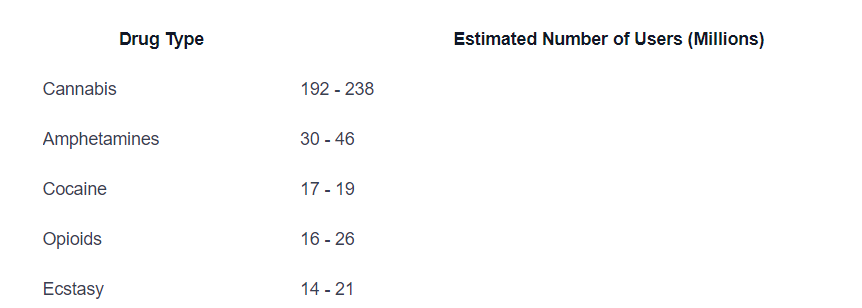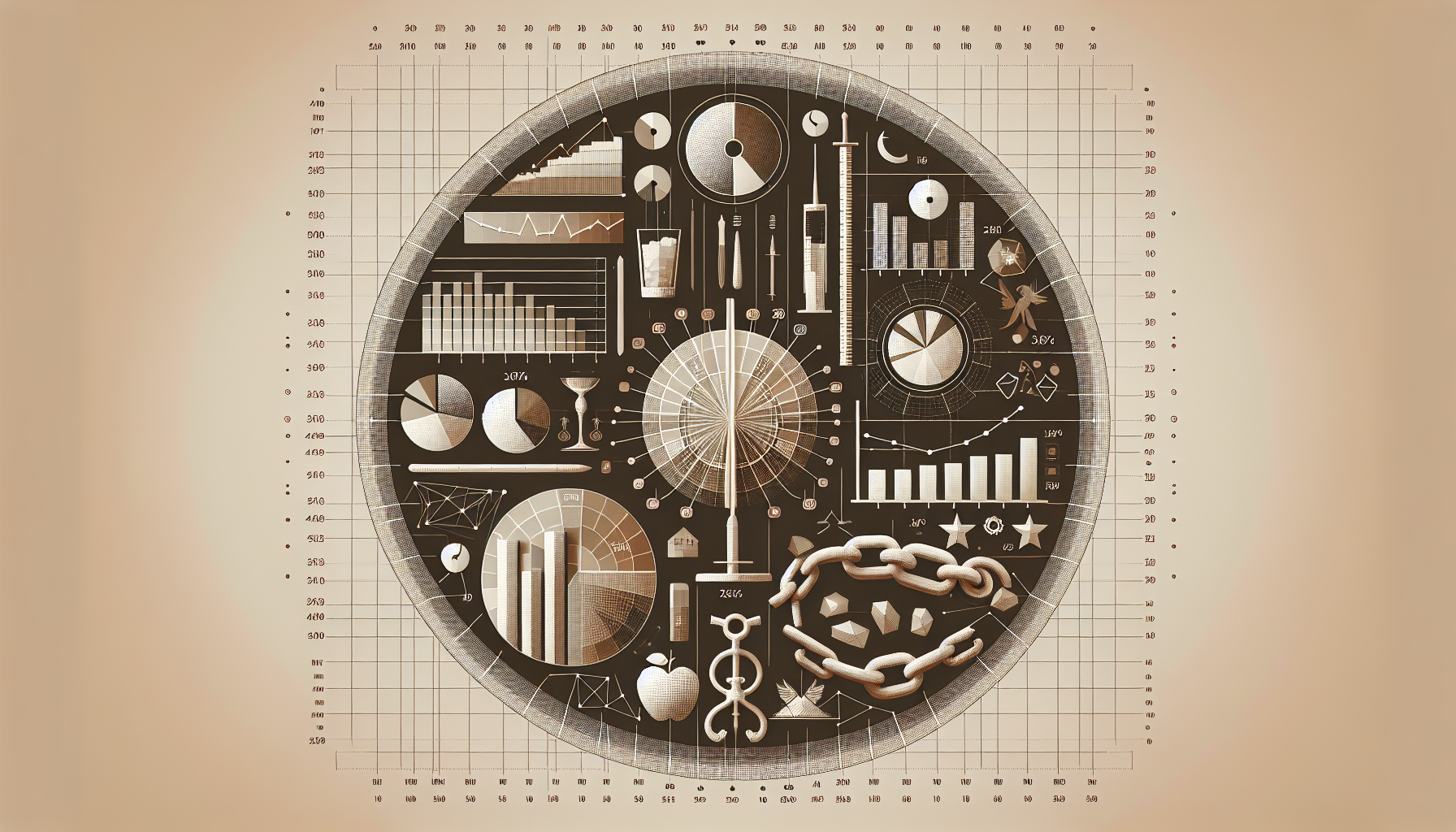Understanding Addiction Statistics
To shed light on the prevalence and impact of addiction, it is essential to explore addiction statistics. These figures provide insights into the scope of the problem and help identify areas that require attention. By understanding addiction statistics, policymakers, healthcare professionals, and individuals can work towards effective prevention, treatment, and support systems.
Overview of Addiction
Addiction is a growing problem in America, affecting individuals from all walks of life. It is characterized by the compulsive use of substances or engagement in activities despite negative consequences. Commonly abused substances include drugs, alcohol, nicotine, and even behaviors like gambling or excessive technology use.
According to the National Institute on Drug Abuse, drug overdose deaths in the United States surpassed 100,000 in a single year, the highest number in the country’s history [2]. Shockingly, only 13% of people with drug use disorders received any treatment in 2020. These statistics highlight the urgent need for increased access to addiction treatment and support services.
Risk factors for addiction can vary, but some common factors include genetic predisposition, mental health issues, environmental influences, and exposure to trauma or stress [1]. It is important to recognize that addiction is a complex condition, and addressing it requires a comprehensive approach that considers various factors.
Looking toward the future, research is focused on developing new treatment methods and approaches to address addiction-related issues [1]. Clinical trials are exploring additional endpoints beyond complete abstinence, such as reduced substance use, to evaluate the effectiveness of medications and interventions. This broader perspective aims to facilitate the approval of a wider range of medications and therapies to treat addiction and address associated symptoms like sleep disorders and anxiety [2].
It is important to approach addiction treatment and recovery with understanding and support. Temporary setbacks and relapses are common, as addiction is often described as a chronic relapsing condition. Society should avoid stigmatizing individuals who experience setbacks, as unnecessary guilt and shame can hinder progress.
By understanding addiction statistics and the complexities of addiction, we can work together to address this hidden epidemic and provide individuals with the support they need to overcome addiction.
Commonly Abused Substances
When examining addiction statistics, it is essential to understand the commonly abused substances that contribute to this ongoing issue. Two significant categories of substances that frequently lead to addiction are stimulants and opioids.
Stimulants and Their Impact
Stimulants are drugs that increase brain activity, providing a sense of alertness and euphoria. They are often used to treat conditions such as attention deficit hyperactivity disorder (ADHD) and narcolepsy. However, the non-medical use of stimulants can lead to addiction and various negative health effects.
One well-known stimulant is cocaine, derived from the leaves of the coca plant native to South America. According to the National Institute on Drug Abuse, cocaine is an extremely addictive drug that can have severe consequences for individuals who misuse it.
Another widely abused stimulant is methamphetamine, commonly referred to as meth. It is a powerful and highly addictive substance that affects the central nervous system. Prolonged use of meth can lead to severe health issues and addiction.
Opioids and Addiction
Opioids are medications that are primarily used for pain relief. They work by binding to opioid receptors in the brain, reducing the perception of pain and producing feelings of euphoria. Unfortunately, opioids can also be highly addictive, leading to widespread misuse and addiction.
One commonly abused opioid is heroin, an illegal drug derived from morphine, which itself is extracted from the seed pod of opium poppy plants. Heroin use has devastating consequences and is associated with a high risk of overdose.
Prescription opioids, such as oxycodone and hydrocodone, are also frequently misused. Despite their medical benefits, these drugs can be highly addictive and pose a significant risk for individuals who misuse them.
It is important to note that the misuse and addiction to both stimulants and opioids are serious public health concerns. Understanding the impact of these substances is crucial for addressing addiction on a larger scale. For more information on addiction and its related statistics, refer to our article on mental health issues related to addiction statistics.
Health Effects of Substance Abuse
Substance abuse can have significant long-term health consequences. Understanding the health effects of substance abuse is crucial in addressing addiction and promoting overall well-being. In this section, we will explore the long-term effects of methamphetamine (meth) use and chronic marijuana use.
Long-Term Effects of Meth Use
Long-term meth use and addiction are associated with a range of adverse effects that can have a severe impact on a person’s physical and mental health. Some of the common long-term effects of meth use include:
- Dental Problems: Methamphetamine use can lead to severe dental problems, including tooth decay, gum disease, and tooth loss. These issues are often referred to as “meth mouth” and can have a significant impact on oral health.
- Weight Loss: Chronic meth use can cause significant weight loss. This is often due to a combination of factors, including decreased appetite and increased physical activity associated with the drug’s stimulant effects.
- Skin Sores: Meth use can lead to the development of sores on the skin, which may result from scratching or picking at the skin due to the drug’s stimulant properties. These sores can become infected and may leave scars.
- Psychotic Consequences: Long-term meth use can cause serious psychotic consequences, such as paranoia, hallucinations, and delusions. These effects may persist for months or even years after meth use has stopped.
It’s important to seek professional help and support for individuals struggling with meth addiction to address these long-term health effects and work towards recovery.
Chronic Marijuana Use Effects
Chronic marijuana use, especially heavy and prolonged use, can also have long-term health effects. While marijuana is generally considered to have a lower risk profile compared to some other substances, it is not without potential risks. Some of the effects associated with chronic marijuana use include:
- Cannabinoid Hyperemesis Syndrome: Chronic marijuana use may lead to a rare condition known as cannabinoid hyperemesis syndrome. This condition is characterized by cyclic and severe nausea, vomiting, and dehydration. It can significantly impact a person’s quality of life and may require medical intervention [3].
- Respiratory Issues: Smoking marijuana can have negative effects on the respiratory system, similar to smoking tobacco. Chronic marijuana smokers may experience symptoms such as chronic bronchitis, cough, and increased mucus production.
- Cognitive Effects: Heavy and prolonged marijuana use, especially when initiated during adolescence, has been associated with cognitive impairments, such as decreased attention, memory, and problem-solving skills. These effects may persist even after marijuana use has stopped.
It’s important to note that the effects of marijuana can vary depending on factors such as frequency of use, dosage, and individual susceptibility. If you or someone you know is struggling with marijuana addiction, seeking professional help can provide the necessary support for managing and overcoming these effects.
Understanding the long-term effects of substance abuse is crucial in promoting awareness, prevention, and effective treatment strategies. By addressing the health consequences associated with addiction, individuals can take steps towards recovery and improved well-being.
Global Drug Use Trends
Understanding global drug use trends is essential in addressing the widespread issue of addiction. By examining illicit drug use worldwide and considering the variations in drug use by gender and region, we can gain valuable insights into the scope of this problem.
Read about: Autism and Addiction’s Close Connections
Illicit Drug Use Worldwide
The number of illicit drug users worldwide has shown significant variations over the years. According to Statista, the estimated number of illicit drug users ranged from millions globally between 1990 and 2021. The global population share of illicit drug use in 2021 varied by drug type, highlighting the prevalence of drug use worldwide.
To provide further context, let’s consider some specific examples of illicit drug use:

These figures highlight the significant number of individuals affected by illicit drug use globally. It is crucial to address this issue through prevention, education, and access to appropriate treatment.
Drug Use by Gender and Region
The distribution of illicit drug users worldwide varies by gender and region. Statista provides insights into this aspect of drug use. Here are some key findings:
- In terms of gender, the distribution of illicit drug users worldwide as of 2021 varied by drug type. For example, the percentage of male cannabis users was higher than that of females, while the percentage of female amphetamine users was slightly higher than that of males.
- When examining drug use by region, the prevalence of illicit drug use varies across different parts of the world. Factors such as availability, cultural norms, socioeconomic conditions, and law enforcement efforts can contribute to these regional differences.
Understanding the gender and regional variations in drug use is crucial for the development and implementation of effective prevention and intervention strategies. By tailoring approaches to specific populations and regions, we can better address the unique challenges associated with drug use.
By examining global drug use trends, including illicit drug use worldwide and the variations in drug use by gender and region, we gain a more comprehensive understanding of the magnitude of addiction. This knowledge can inform efforts to prevent substance abuse, promote treatment options, and support individuals affected by addiction worldwide.
Demographics and Addiction
When examining addiction statistics, it is important to consider the various demographic factors that can influence substance abuse patterns. In this section, we will explore the relationship between addiction and college students as well as the racial disparities in drug use.
College Students and Drug Use
According to a study published by the National Center for Biotechnology Information (NCBI), the use of marijuana and other illicit drugs has increased significantly among college students in the U.S. over the past decade. Young adults between the ages of 18 to 29 have the highest past-year prevalence rates of marijuana use, abuse, and dependence relative to older age groups [4]. In fact, young adults aged 18 to 25 reported the highest rates of lifetime, past year, and past month use of any illicit drug, with the prevalence of past-year illicit drug use by college students aged 18 to 22 years comparable to their same-age peers not attending college.
The study also examined the 12-month prevalence rates of drug use among undergraduate college students based on race/ethnicity and gender. It found that marijuana was the most commonly used substance among college students, followed by opioid analgesics, prescription stimulants, and psychedelics. Hispanic and White students generally had higher rates of drug use compared to Asian and African American students. Additionally, Hispanic students had the highest rates of drug use and drug use-related problems, while White students had higher rates of illicit drug use compared to African American and Asian college students [4]. Illicit use of prescription drugs was second only to marijuana use across all genders and racial groups, with higher rates among male college students compared to females. White and Hispanic students also had higher rates of illicit drug use compared to African American students [4].
Racial Disparities in Drug Use
The study mentioned above also revealed racial disparities in drug use among college students. Hispanic and White students exhibited higher rates of drug use compared to African American and Asian college students. Hispanic students had the highest rates of drug use and drug use-related problems, while White students had higher rates of illicit drug use compared to African American and Asian college students [4]. Additionally, White and Hispanic students had higher rates of illicit drug use compared to African American students.
Understanding the demographics of drug use is essential for developing targeted prevention and intervention strategies. By recognizing the specific patterns and disparities in drug use among college students and different racial groups, health professionals and policymakers can implement more effective approaches to address substance abuse issues and provide necessary support.
In the next section, we will explore the barriers to addiction treatment and the evolving trends in addiction treatment methods.
Treatment and Prevention
When it comes to addressing addiction, treatment and prevention play crucial roles in helping individuals overcome substance abuse and related challenges. In this section, we will explore some of the barriers to addiction treatment and discuss the trends in addiction treatment.
Barriers to Addiction Treatment
While seeking addiction treatment is essential, there are several barriers that individuals may face when trying to access the help they need. These barriers can include:
- Stigma: The stigma surrounding addiction can prevent individuals from seeking treatment due to fear of judgment or discrimination. It is important to combat stigma and promote understanding and empathy towards those struggling with addiction.
- Lack of Access to Treatment Centers: Limited availability of addiction treatment centers, particularly in rural areas, can make it challenging for individuals to access the necessary care. Improving access to treatment facilities and resources is crucial for effective treatment and prevention.
- Financial Constraints: The cost of addiction treatment can be a significant barrier for many individuals. Treatment options can vary in price, and not everyone has the financial means to afford them. Expanding insurance coverage and increasing funding for affordable treatment options can help address this barrier.
- Lack of Awareness and Education: Many individuals may not be aware of the available treatment options or may have misconceptions about addiction and its treatment. Education and awareness campaigns can help disseminate accurate information and encourage individuals to seek help.
Addressing these barriers is crucial to ensure that individuals struggling with addiction have access to the support and treatment they need.
Trends in Addiction Treatment
The field of addiction treatment is constantly evolving, with a focus on incorporating new approaches and advancements to improve outcomes. Some notable trends in addiction treatment include:
- Individualized Treatment: Recognizing that addiction affects individuals differently, treatment approaches are increasingly tailored to meet the unique needs of each person. This personalized approach helps address the underlying factors contributing to addiction and provides targeted support.
- Integrated Care: Treating addiction alongside other co-occurring mental health disorders is crucial for comprehensive care. Integrated treatment models that address both addiction and mental health simultaneously have shown promising results in improving long-term outcomes.
- Medication-Assisted Treatment (MAT): MAT involves the use of medications, in combination with counseling and behavioral therapies, to treat substance use disorders. Medications are used to manage withdrawal symptoms, reduce cravings, and support long-term recovery. This approach has been particularly effective for opioid addiction.
- Expanded Use of Technology: Technology has become increasingly integrated into addiction treatment. Telehealth services, online counseling, and mobile applications provide convenient access to treatment and support, particularly in remote or underserved areas.
- Focus on Holistic Approaches: Recognizing the importance of addressing all aspects of an individual’s well-being, holistic approaches to addiction treatment have gained traction. These approaches encompass physical, mental, and emotional well-being, incorporating practices such as mindfulness, yoga, and nutrition.
The future of addiction treatment holds promise as research explores new medications, therapies, and interventions to improve outcomes and address associated symptoms like sleep disorders and anxiety [2]. By staying informed about the latest trends and developments in addiction treatment, individuals and healthcare providers can make more informed decisions regarding treatment options.
Understanding the barriers to addiction treatment and staying updated on emerging trends can help pave the way for effective prevention and comprehensive care for individuals struggling with addiction. It is important to promote access to treatment, reduce stigma, and continue to explore innovative approaches to improve the lives of those affected by addiction.




